IDEX Online Research: Fallout from a Weak 2008 Holiday Selling Season
January 28, 09
Darwin’s theory of evolution – the strong will survive and the weak will perish – goes far beyond wild nature. Among other things, it summarizes the process that weeds out the weak merchants in the retail industry.
Because of the very poor 2008 holiday selling season in the U.S. market and most global markets, it should come as no surprise that consolidation in the jewelry industry is expected to accelerate in 2009.
Here are a few of the things we see happening in the jewelry industry this year. The list is by no means exhaustive. Rather, it highlights some of the more likely scenarios. After you’ve read over this list, we’d like to hear from you. What do you see happening? We’ll publish a roundup of your observations and thoughts. Just send your outlook to research [at] idexonline [dot] com, including your contact information. We promise strict anonymity to those that ask for it.
Outlook: Consolidation to Accelerate At All Levels of Distribution Channel
Because of a weak holiday selling season in 2008, the following is our outlook:
- We expect to see a large number of retail jewelers close their doors in 2009, because of weak performance in the 2008 holiday selling period. Most jewelers generate about one-third of their annual sales in the November-December period, and some generate all of their annual profit in that two-month period. Thus, we expect banks to call credit lines and force some jewelers out of business.
- In 2008, just over 600 jewelers went out of business, according to the Jewelers Board of Trade (JBT). This was slightly below the average number of annual closings – 700+ – over the past decade. However, this number masks some major closings. The JBT census counts only companies, not doors. Thus, for example, Whitehall and Friedman’s are counted only once each in the JBT census, despite these chains closing well over a thousand stores.
- We believe that at least 1,500 – and perhaps as many as 2,000 – jewelry doors closed in 2008. This means that the industry lost more or less about 5 percent of its retail capacity (most of the closes stores probably posted below average sales). The total number of doors which closed in 2008 will be reported late in 2009 by the government. We believe our estimates are in line with actual results.
- During 2009, we expect an accelerating number of independent jewelers to shutter their stores, but it is unlikely that the number of doors closing will be as high as in 2008. However, if a major chain closes, the number of doors closing could rise significantly.
- The JBT census reports that there were about 22,623 retail jewelers in the U.S. at the end of 2008 (chains each count as one of these jewelers). Based on historic trends, it would not be unreasonable to see up to a net 1,000 company closings in 2009 (an estimated 200 openings and 900 closings). However, we believe that most of these closings will be single-store operators. This would suggest that another 4 percent or so of industry capacity, at retail, could be eliminated in 2009.
The graph below summarizes our forecast for the change in the retail jewelry census in 2009.
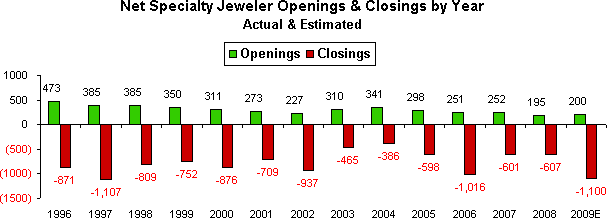
Source: Jewelers Board of Trade
Chain Jewelers Gain; Independents Lose
Despite some significant chain closings in 2008 – namely Whitehall and Friedman’s – the long term trend shows that for every independent store which closes, a chain store opens. We believe that this trend will continue, though perhaps at a slower pace in 2009 and beyond.
Most chain jewelers have indicated that they are either reducing new store openings or essentially eliminating store expansion. For example, Sterling Jewelers normally adds new store space at about 8-9 percent annually. In 2009, we expect its new store openings to dwindle to no new net gain in store square footage for the year. Zale continues to shed stores. Tiffany has said it will slow new store expansion to 5 percent or so new selling square footage in 2009, about half the pace it normally posts.
The point is this: while chain jewelers are unlikely to generate any notable new square footage in 2009 in the aggregate, independents are likely to lose selling space, based on our projected closures during the year.
The graph below illustrates the long term trend which suggests that chain growth, while slowing in the past couple of years, remains more robust than independent’s growth. The green bar illustrates the number of jewelry companies which operate stores. Chains like Kay and Zale are counted as one unit. The red bar illustrates the number of jewelry stores in operation in the U.S. market. Store census data for 2007 and 2008 are preliminary and based on our estimates.
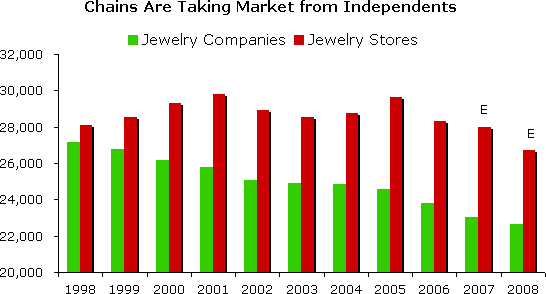
Source: Jewelers Board of Trade, US Census Department
Should jewelers be worried about this trend? We tend to look at it positively. We believe the jewelry market will continue to grow long term, driven by a population gain, an increase in weddings, and higher per capita income, among other factors. Thus, there will be fewer stores serving a growing market: that’s good for the surviving merchants.
Specialty Jewelers Losing Market Share to Multi-line Merchants
These jewelers tend to lose market share at a greater rate during and just after a recessionary period. Typically, they don’t recover the lost market share.
The graph below illustrates how specialty jewelers have lost market share over the past several decades. Ironically, just as jewelers appeared to be regaining market share in 1980 and 1981, the U.S. economy hit the skids, and they lost significant market share over the following decade.
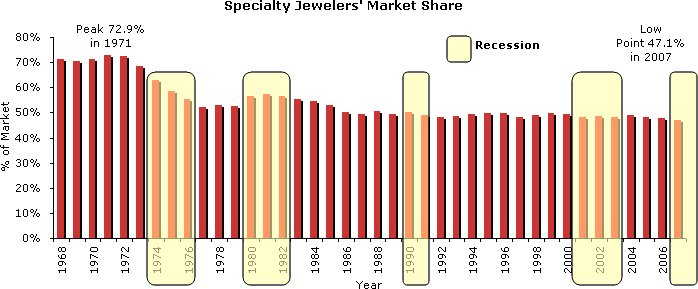
Source: NBER, BLS, JIRI, US Dept of Commerce
Wholesalers and Manufacturers Will Diminish
Along with retailers, the census of U.S.-based jewelry wholesalers and manufacturers is projected to decline. There are many reasons that the number of upstream suppliers in the U.S. will likely diminish:
- More producers are moving overseas where labor costs and operating conditions are more favorable.
- Small producers can’t compete efficiently against growing large-scale suppliers.
- Mergers and acquisitions have increased, reducing the total number of suppliers.
- The surviving retailers have cut back on the total number of vendors with whom they will do business. This has put some suppliers out of business.
- The upstream pipeline is generally fragmented. No single supplier, nor no small group of suppliers, has pricing power. Thus, price is the major competitive differential. The suppliers who cannot product goods efficiently enough to compete on price are being driven out of business.
The graph below illustrates the trend in the number of wholesalers in the U.S. market. This data is from the JBT. At the end of 2007, JBT restated the census of wholesalers due to a reclassification. Thus, the census from 1996 through 2007 should be viewed as a unit, while the trend from 2007R and 2008 should be viewed as a unit. During 2008, the U.S. lost a net of 22 jewelry wholesalers. This was the result of 39 openings and 61 closings.
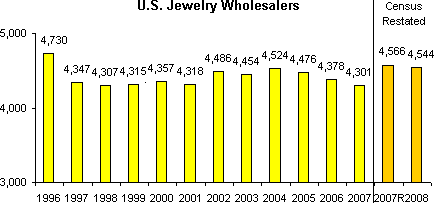
Source: Jewelers Board of Trade
Similarly, the number of U.S. jewelry manufacturers has also declined, as the graph below illustrates. Again, JBT restated the census of manufacturers due to a reclassification. During 2008, the U.S. lost a net of 70 jewelry manufacturers. This was the result of 25 openings and 95 closings.
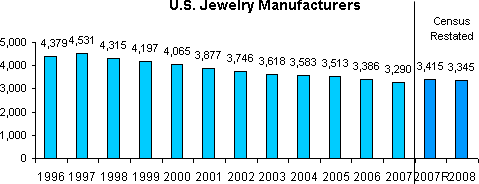
Source: Jewelers Board of Trade
Other Potential Trends
Other trends will emerge as fallout from a weak 2008 holiday selling season. Some of those trends include the following:
- Suppliers will trim their product offerings. In an effort to produce goods with a lower per-unit cost, suppliers will likely opt for longer production runs to achieve efficiencies of scale.
- Retailers will focus on increasing inventory turn. Margins will still matter, but jewelers will increasingly focus on GMROI – gross margin return on investment – which suggests that merchants could take smaller mark-ups in exchange for a faster inventory turn. This would enhance overall profitability.
- Vertical integration will increase. Indian diamond suppliers will drive the trend as they seek retail partners in the U.S. and perhaps other global markets.
There will be other trends to emerge.
Your Turn
What trends do you see emerging in 2009? Drop us an e-mail at research [at] idexonline [dot] com. We’ll publish a roundup of comments from your crystal ball.